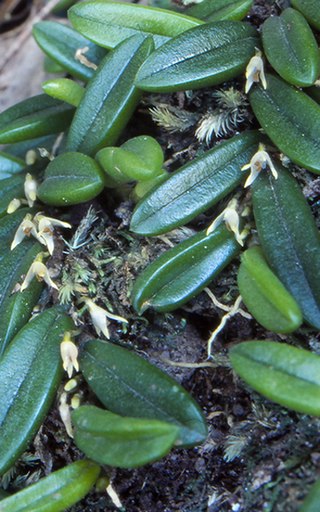
Grevillea erectiloba is a species of flowering plant in the family Proteaceae and is endemic to inland areas of south-west of Western Australia. It is dense, rounded shrub with divided leaves with up to fifteen linear lobes, and groups of bright red flowers that are green in the bud stage.

Olearia axillaris, commonly known as coastal daisy-bush, coast daisy-bush or coastal daisybush is a species of flowering plant in the family Asteraceae and is endemic to coastal areas of Australia. It is an erect, bushy shrub with densely cottony-hairy branchlets, aromatic, linear to narrowly elliptic or narrowly lance-shaped to egg-shaped leaves with the narrower end towards the base and small white and yellow, daisy-like inflorescences.

Bulbophyllum shepherdii, commonly known as the wheat-leaf rope orchid, is a species of epiphytic or lithophytic orchid that forms a dense mat of branching rhizomes pressed against the surface on which it grows. The pseudobulbs are well spaced along the rhizome, each with a single egg-shaped leaf and a single small, white or cream-coloured flower with yellow tips. It grows on trees and rocks in rainforest and is endemic to eastern Australia.

Olearia stuartii is a species of flowering plant in the family Asteraceae and is endemic arid parts of inland Australia. It is compact, spreading shrub or undershrub with lance-shaped leaves and blue to mauve and yellow, daisy-like inflorescences.

Pimelea congesta is a species of flowering plant in the family Thymelaeaceae and is endemic to Lord Howe Island in Australia. It is a shrub with rough bark, decussate, elliptic leaves and heads of white flowers.
Stenocarpus acacioides is a species of flowering plant in the family Proteaceae and is endemic to north-western Australia. It is a shrub or tree with elliptic leaves and groups of white flowers and woody, linear follicles.

Boronia lanceolata is a plant in the citrus family Rutaceae and is endemic to northern parts of the Northern Territory and Queensland. It is an erect shrub with many branches, elliptic to lance-shaped leaves and white or pink, four-petalled flowers. It is the most common boronia in the Northern Territory.

Pimelea aeruginosa is a species of small shrub in the family Thymelaeaceae. It is a small shrub with yellow flowers and is endemic to Western Australia.

Pimelea ammocharis is a species of small shrub in the family Thymelaeaceae. It is a small shrub with white-yellow to orange flowers and is endemic to Western Australia.

Prostanthera wilkieana is a species of flowering plant that is endemic to the more arid areas of Australia. It is an erect, densely-branched shrub with elliptic to narrow egg-shaped leaves with the narrower end towards the base and mauve to pale violet or white flowers with deep purple streaks and yellowish brown dots inside the petal tube.
Goodenia stenophylla is a species of flowering plant in the family Goodeniaceae and is endemic to the south-west coast of Western Australia. It is an erect shrub with linear or tapering leaves and racemes of white flowers with purplish spots.
Pomaderris forrestiana is a species of flowering plant in the family Rhamnaceae and is endemic to south-western Australia. It is a low shrub with elliptic leaves, and small clusters of woolly-hairy flowers.
Olearia gravis is a species of flowering plant in the family Asteraceae and is endemic to south-eastern Australia. It is a shrub with elliptic or egg-shaped leaves and white and yellow, daisy-like inflorescences.

Olearia nernstii is a species of flowering plant in the family Asteraceae and is endemic to eastern Australia. It is a shrub with scattered egg-shaped to elliptic leaves with toothed or prickly edges, and white and yellow, daisy-like inflorescences.
Pimelea concreta is a species of flowering plant in the family Thymelaeaceae and is native to northern Australia and parts of Indonesia. It is an annual herb with narrowly egg-shaped leaves and head-like clusters of white or pink, tube-shaped flowers surrounded by egg-shaped green involucral bracts.
Pimelea eyrei is a species of flowering plant in the family Thymelaeaceae and is endemic to the southwest of Western Australia. It is an erect shrub with hairy, narrowly elliptic leaves and clusters of densely hairy, white or cream-coloured flowers.
Pimelea forrestiana is a species of flowering plant in the family Thymelaeaceae and is endemic to Western Australia. It is a shrub with linear to narrowly elliptic leaves arranged in opposite pairs, and head-like clusters of yellow, tube-shaped flowers.

Pimelea haematostachya, commonly known as pimelea poppy, is a species of flowering plant in the family Thymelaeaceae and is endemic to Queensland. It is a perennial herb with narrowly egg-shaped or narrowly elliptic leaves and heads of red flowers.

Cryptandra longistaminea is a species of flowering plant in the family Rhamnaceae and is endemic to eastern Australia. It is a shrub with many branches, egg-shaped or elliptic to linear leaves, and clusters of white, tube-shaped flowers.
Pimelea holroydii is a species of flowering plant in the family Thymelaeaceae and is endemic to the north of Western Australia. It is an erect shrub with egg-shaped leaves arranged more or less in opposite pairs, and head-like clusters of white or cream-coloured, tube-shaped flowers.












